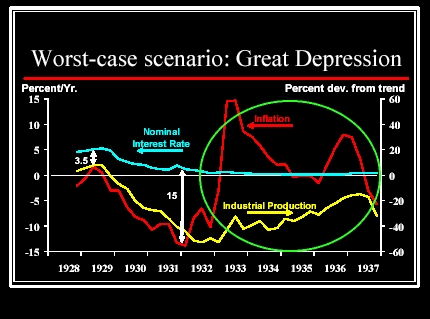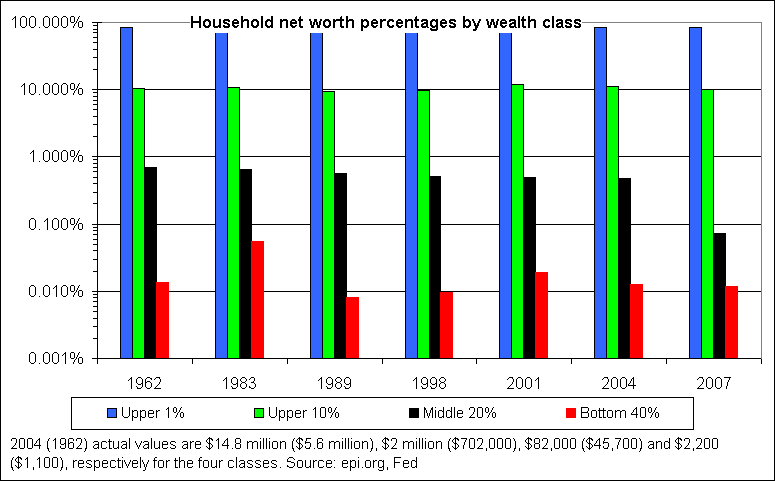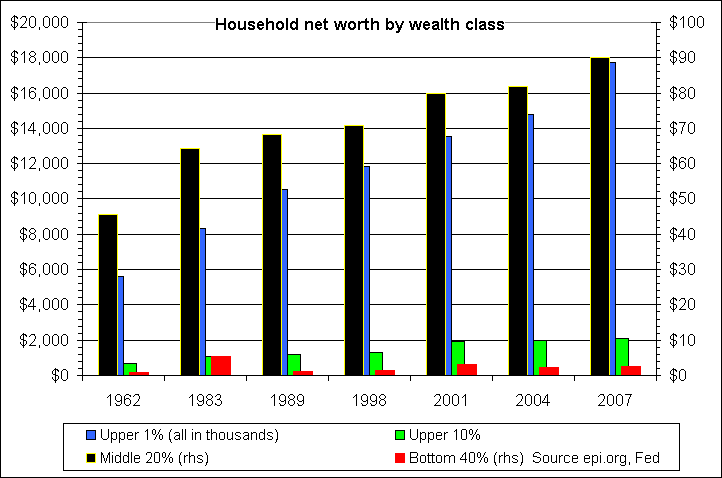In the Shadow of 1937
December 26, 2006 (John Batchelor - NY Sun)
Not since 1937 have the richest 1% of Americans been so far above the average citizen in assets and earning power as today. More, these one percenters are not coupon-clipping, Palm Beach-squatting heirs. They are wage earners and entrepreneurs, and their prospects just get grander as globalization grows the market capitalization of all enterprises. Further, the one percenters are pulling away not only from everyone in general but also from the richest of the rest. Their income has doubled since Ronald Reagan, while in the same time frame the merely rich, the 90th to 95th percentiles, have flatlined.
What this means today, brooding on George Santayana's drollery that you are doomed to repeat the history you don't learn from, is that it is useful to travel back to New York City in 1937 to see what severe and, truth be told, grotesque income disparity might mean in the world of affairs ahead.
AntiSpin: We've drawn the parallel between 2007 and 1937, two periods when government intervention to manage post bubble economic pain, as an unintended consequence, produced wealth and income inequality. Here Batchelor extends the comparison and takes it to its logical conclusion.
The October 19, 2006 iTulip piece Dow 12,000: Not a bubble, but not healthy growth, either" states, "This bounce has more in common with the US market bounce in 1937 that was fueled by the sudden surge of inflation and liquidity produced by the Fed starting in 1933, and the temporary increase in industrial production that followed, as you can see in the charts below."

Batchelor says:
December 26, 2006 (John Batchelor - NY Sun)
Not since 1937 have the richest 1% of Americans been so far above the average citizen in assets and earning power as today. More, these one percenters are not coupon-clipping, Palm Beach-squatting heirs. They are wage earners and entrepreneurs, and their prospects just get grander as globalization grows the market capitalization of all enterprises. Further, the one percenters are pulling away not only from everyone in general but also from the richest of the rest. Their income has doubled since Ronald Reagan, while in the same time frame the merely rich, the 90th to 95th percentiles, have flatlined.
What this means today, brooding on George Santayana's drollery that you are doomed to repeat the history you don't learn from, is that it is useful to travel back to New York City in 1937 to see what severe and, truth be told, grotesque income disparity might mean in the world of affairs ahead.
AntiSpin: We've drawn the parallel between 2007 and 1937, two periods when government intervention to manage post bubble economic pain, as an unintended consequence, produced wealth and income inequality. Here Batchelor extends the comparison and takes it to its logical conclusion.
The October 19, 2006 iTulip piece Dow 12,000: Not a bubble, but not healthy growth, either" states, "This bounce has more in common with the US market bounce in 1937 that was fueled by the sudden surge of inflation and liquidity produced by the Fed starting in 1933, and the temporary increase in industrial production that followed, as you can see in the charts below."

Batchelor says:
The rich got richer in 1937 not only because of their assets but also because of a deepening worldwide deflation that, destabilizing democracies, favored strongmen on all continents. In Spain, in the proxy war between communist Russia and capitalist Europe, leftist rebels claimed that two "Reich Divisions" were en route to aid the government forces under Francisco Franco. In Moscow, the mood was drunken self-denial, the crammed Metropol Hotel charging 115 rubles for half a bottle of foul Soviet champagne. In Berlin the mood was grim ambition. Propagandist Joseph Goebbels's official newspaper, Angriff, asked, "Will War Come Automatically?" Four-Year Plan boss Hermann Goering proclaimed, "Full steam ahead to assure German honor and German rights." And Hitler admonished, "Fulfill in the new year the eternal watchword, ‘Everything for Germany'."
Actually, the rise of strongmen has a greater correlation to hyper-inflation than deflation. Nations that suffered deflation during The Great Depression tended to maintain their democratic institutions. Quoting from the iTulip bible, galbraithmoney by John Kenneth Galbraith (Houghton Mifflin, 1975), Economic woes leading to Fascism or Communism: The Economic Policies of Hitler:"That the great German inflation, like the ones elsewhere in central Europe, produced a large transfer of wealth from those who possessed saving accounts, money, securities or mortgages to those who had debts or tangible property is assumed. And, despite a shortage of affirming statistics, that such transfer occurred does seem plausible. The loss so involved, the parallel lost by people of their stake in the social order and the companion anger and frustration were, in turn, thought to have much to do with the rise of Fascism or Communism. These are matters on which there is no proof, and it is unbecoming, however customary, to substitute certainty of statement for hard evidence. But the simple facts are worth a glance. All of the countries of central Europe that suffered a collapse of their currencies following the First World War were eventually to experience Fascism, Communism or in most cases - Poland, Hungary, East Germany - both. The countries that did not experience such a breakdown in their money were almost uniformly more fortunate."
To take Batchelor's points a step further, it is likely that Japan's "lost decade" combined with the threats posed by an increasingly economically powerful and militarized China produced the social shift in Japan that resulted in the election of the hawkish Japanese Prime Minister Shinzo Abe. After a decade of economic slough, Japan is surging back. Amid signs that it is maintaining its economic recovery, the land of the rising sun recently took two significant steps toward shaking the bogeyman of its World War ii legacy and reasserting Japanese nationalism.
On Friday, December 15, the Japanese Parliament passed a bill that upgraded the Japanese Defense Agency to full ministry status. This takes the new Japanese Defense Ministry into the cabinet arena along with other top government departments. Significantly, the defense bill enjoyed the support of the Diet’s main opposition Democratic Party, making it, with the exception of two minor opposition parties, a virtual bipartisan affair.
All that now remains for Japan to finally legitimize itself as a fully fledged member of the international community empowered by parliamentary authority to act militarily, both defensively and offensively, beyond its own shores, is to change Article 9 of its postwar constitution which, in theory, presently prevents Japan from so engaging. Shinzo Abe is on track to obtain that change during his first tenure as prime minister.
Barely an hour following this historic change in the Japanese government, another bill was approved along party lines requiring schools to teach patriotism. Consistent with Prime Minister Abe’s efforts to have Japan shed remaining taboos associated with the nation’s inglorious defeat in World War ii, the Japanese leader had made this legislation a key plank in his political platform. He understands clearly that the old generation that still remembers that huge national loss of face is dying out. The new generation needs a fresh focus on the nation’s future. To this end, schools will now be charged with the responsibility to generate and instill a new sense of national pride in their students. Japan—on the Rise Again
A distinct rise in militarism and idealism, paralleling a decline in diplomatic engagement and pragmatism, is spanning the globe, from East to West. A more nationalist Japan is but one of the wild-card geopolitical antecedents for political turmoil in the next few years as the liquidity driven economic boom of the past four years winds down and a major global recession begins, much as during the period following 1937.On Friday, December 15, the Japanese Parliament passed a bill that upgraded the Japanese Defense Agency to full ministry status. This takes the new Japanese Defense Ministry into the cabinet arena along with other top government departments. Significantly, the defense bill enjoyed the support of the Diet’s main opposition Democratic Party, making it, with the exception of two minor opposition parties, a virtual bipartisan affair.
All that now remains for Japan to finally legitimize itself as a fully fledged member of the international community empowered by parliamentary authority to act militarily, both defensively and offensively, beyond its own shores, is to change Article 9 of its postwar constitution which, in theory, presently prevents Japan from so engaging. Shinzo Abe is on track to obtain that change during his first tenure as prime minister.
Barely an hour following this historic change in the Japanese government, another bill was approved along party lines requiring schools to teach patriotism. Consistent with Prime Minister Abe’s efforts to have Japan shed remaining taboos associated with the nation’s inglorious defeat in World War ii, the Japanese leader had made this legislation a key plank in his political platform. He understands clearly that the old generation that still remembers that huge national loss of face is dying out. The new generation needs a fresh focus on the nation’s future. To this end, schools will now be charged with the responsibility to generate and instill a new sense of national pride in their students. Japan—on the Rise Again


Comment